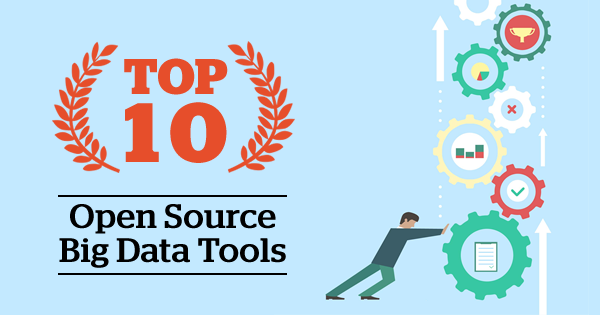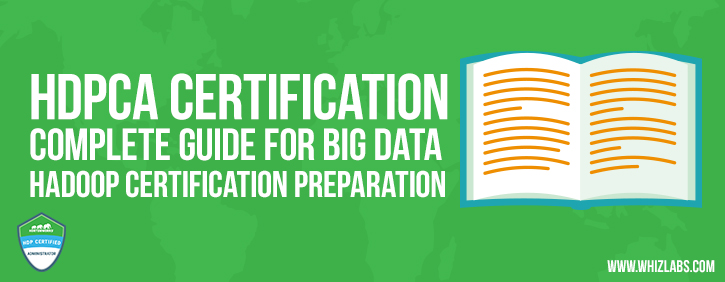Today almost every organization extensively uses big data to achieve the competitive edge in the market. With this in mind, open source big data tools for big data processing and analysis are the most useful choice of organizations considering the cost and other benefits. Hadoop is the top open source project and the big data bandwagon roller in the industry. However, it is not the end! There are plenty of other vendors who follow the open source path of Hadoop.
Now, when we talk about big data tools, multiple aspects come into the picture concerning it. For example how large the data sets are, what type of analysis we are going to do on the data sets, what is the expected output etc. Hence, broadly speaking we can categorize big data open source tools list in following categories: based on data stores, as development platforms, as development tools, integration tools, for analytics and reporting tools.
Preparing for Big Data interview? Here’re the top 50 Big Data interview questions with detailed answers to crack the interview!
Why There are So Many Open Source Big Data Tools in the Market?
No doubt, Hadoop is the one reason and its domination in the big data world as an open source big data platform. Hence, most of the active groups or organizations develop tools which are open source to increase the adoption possibility in the industry. Moreover, an open source tool is easy to download and use, free of any licensing overhead.
If we closely look into big data open source tools list, it can be bewildering. As organizations are rapidly developing new solutions to achieve the competitive advantage in the big data market, it is useful to concentrate on open source big data tools which are driving the big data industry.
Top 10 Best Open Source Big Data Tools in 2020
Based on the popularity and usability we have listed the following ten open source tools as the best open source big data tools in 2020.
1. Hadoop
Apache Hadoop is the most prominent and used tool in big data industry with its enormous capability of large-scale processing data. This is 100% open source framework and runs on commodity hardware in an existing data center. Furthermore, it can run on a cloud infrastructure. Hadoop consists of four parts:
- Hadoop Distributed File System: Commonly known as HDFS, it is a distributed file system compatible with very high scale bandwidth.
- MapReduce: A programming model for processing big data.
- YARN: It is a platform used for managing and scheduling Hadoop’s resources in Hadoop infrastructure.
- Libraries: To help other modules to work with Hadoop.
Planning to build a career in Big Data Hadoop? Here are the 20 Most Important Hadoop Terms that You Should Know to become a Hadoop professional.
2. Apache Spark
Apache Spark is the next hype in the industry among the big data tools. The key point of this open source big data tool is it fills the gaps of Apache Hadoop concerning data processing. Interestingly, Spark can handle both batch data and real-time data. As Spark does in-memory data processing, it processes data much faster than traditional disk processing. This is indeed a plus point for data analysts handling certain types of data to achieve the faster outcome.
Apache Spark is flexible to work with HDFS as well as with other data stores, for example with OpenStack Swift or Apache Cassandra. It’s also quite easy to run Spark on a single local system to make development and testing easier.
Spark Core is the heart of the project, and it facilitates many things like
- distributed task transmission
- scheduling
- I/O functionality
Spark is an alternative to Hadoop’s MapReduce. Spark can run jobs 100 times faster than Hadoop’s MapReduce. If you want to know the reason, please read our previous blog on Top 11 Factors that make Apache Spark Faster.
Interested to know how important is the Apache Spark? Read this article to know the Importance of Apache Spark in Big Data Industry.
3. Apache Storm
Apache Storm is a distributed real-time framework for reliably processing the unbounded data stream. The framework supports any programming language. The unique features of Apache Storm are:
- Massive scalability
- Fault-tolerance
- “fail fast, auto restart” approach
- The guaranteed process of every tuple
- Written in Clojure
- Runs on the JVM
- Supports direct acrylic graph(DAG) topology
- Supports multiple languages
- Supports protocols like JSON
Storm topologies can be considered similar to MapReduce job. However, in case of Storm, it is real-time stream data processing instead of batch data processing. Based on the topology configuration, Storm scheduler distributes the workloads to nodes. Storm can interoperate with Hadoop’s HDFS through adapters if needed which is another point that makes it useful as an open source big data tool.
4. Cassandra
Apache Cassandra is a distributed type database to manage a large set of data across the servers. This is one of the best big data tools that mainly processes structured data sets. It provides highly available service with no single point of failure. Additionally, it has certain capabilities which no other relational database and any NoSQL database can provide. These capabilities are:
- Continuous availability as a data source
- Linear scalable performance
- Simple operations
- Across the data centers easy distribution of data
- Cloud availability points
- Scalability
- Performance
Apache Cassandra architecture does not follow master-slave architecture, and all nodes play the same role. It can handle numerous concurrent users across data centers. Hence, adding a new node is no matter in the existing cluster even at its up time.
5. RapidMiner
RapidMiner is a software platform for data science activities and provides an integrated environment for:
- Preparing data
- Machine learning
- Text mining
- Predictive analytics
- Deep learning
- Application development
- Prototyping
This is one of the useful big data tools that support different steps of machine learning, such as:
- Data preparation
- Visualization
- Predictive analytics
- Model validation
- Optimization
- Statistical modeling
- Evaluation
- Deployment
RapidMiner follows a client/server model where the server could be located on-premise, or in a cloud infrastructure. It is written in Java and provides a GUI to design and execute workflows. It can provide 99% of an advanced analytical solution.
Want to expand your Big Data knowledge? Start reading big data blogs. Here we present A Complete List of Big Data Blogs.
6. MongoDB
MongoDB is an open source NoSQL database which is cross-platform compatible with many built-in features. It is ideal for the business that needs fast and real-time data for instant decisions. It is ideal for the users who want data-driven experiences. It runs on MEAN software stack, NET applications and, Java platform.
Some notable features of MongoDB are:
- It can store any type of data like integer, string, array, object, boolean, date etc.
- It provides flexibility in cloud-based infrastructure.
- It is flexible and easily partitions data across the servers in a cloud structure.
- MongoDB uses dynamic schemas. Hence, you can prepare data on the fly and quickly. This is another way of cost saving.
7. R Programming Tool
This is one of the widely used open source big data tools in big data industry for statistical analysis of data. The most positive part of this big data tool is – although used for statistical analysis, as a user you don’t have to be a statistical expert. R has its own public library CRAN (Comprehensive R Archive Network) which consists of more than 9000 modules and algorithms for statistical analysis of data.
R can run on Windows and Linux server as well inside SQL server. It also supports Hadoop and Spark. Using R tool one can work on discrete data and try out a new analytical algorithm for analysis. It is a portable language. Hence, an R model built and tested on a local data source can be easily implemented in other servers or even against a Hadoop data lake.
8. Neo4j
Hadoop may not be a wise choice for all big data related problems. For example, when you need to deal with large volume of network data or graph related issue like social networking or demographic pattern, a graph database may be a perfect choice.
Neo4j is one of the big data tools that is widely used graph database in big data industry. It follows the fundamental structure of graph database which is interconnected node-relationship of data. It maintains a key-value pattern in data storing.
Notable features of Neo4j are:
- It supports ACID transaction
- High availability
- Scalable and reliable
- Flexible as it does not need a schema or data type to store data
- It can integrate with other databases
- Supports query language for graphs which is commonly known as Cypher.
Preparing for any of the Big Data Certification? Complete your preparation with the Big Data Certifications Training that will help you pass the certification exam.
9. Apache SAMOA
Apache SAMOA is among well known big data tools used for distributed streaming algorithms for big data mining. Not only data mining it is also used for other machine learning tasks such as:
- Classification
- Clustering
- Regression
- Programming abstractions for new algorithms
It runs on the top of distributed stream processing engines (DSPEs). Apache Samoa is a pluggable architecture and allows it to run on multiple DSPEs which include
- Apache Storm
- Apache S4
- Apache Samza
- Apache Flink
Due to below reasons, Samoa has got immense importance as the open source big data tool in the industry:
- You can program once and run it everywhere
- Its existing infrastructure is reusable. Hence, you can avoid deploying cycles.
- No system downtime
- No need for complex backup or update process
10. HPCC
High-Performance Computing Cluster (HPCC) is another among best big data tools. It is the competitor of Hadoop in big data market. It is one of the open source big data tools under the Apache 2.0 license. Some of the core features of HPCC are:
- Helps in parallel data processing
- Open Source distributed data computing platform
- Follows shared nothing architecture
- Runs on commodity hardware
- Comes with binary packages supported for Linux distributions
- Supports end-to-end big data workflow management
- The platform includes:
Thor: for batch-oriented data manipulation, their linking, and analytics
Roxie: for real-time data delivery and analytics
- Implicitly a parallel engine
- Maintains code and data encapsulation
- Extensible
- Highly optimized
- Helps to build graphical execution plans
- It compiles into C++ and native machine code
Bottom Line
To step into big data industry, it is always good to start with Hadoop. A certification training on Hadoop associates many other big data tools as mentioned above. Choose any of the leading certification paths either Cloudera or Hortonworks and make yourself market ready as a Hadoop or big data professional.
Whizlabs brings you the opportunity to follow a guided roadmap for HDPCA, HDPCD, and CCA Administrator certification. The certification guides will surely work as the benchmark in your preparation.
- Top 25 Fresher Java Interview Questions - March 9, 2023
- 25 Free Practice Questions – GCP Certified Professional Cloud Architect - December 3, 2021
- 30 Free Questions – Google Cloud Certified Digital Leader Certification Exam - November 24, 2021
- 4 Types of Google Cloud Support Options for You - November 23, 2021
- APACHE STORM (2.2.0) – A Complete Guide - November 22, 2021
- Data Mining Vs Big Data – Find out the Best Differences - November 18, 2021
- Understanding MapReduce in Hadoop – Know how to get started - November 15, 2021
- What is Data Visualization? - October 22, 2021


Thank you for this informative comparison!
Every helpful
Thanks for sharing its really informative and i appreciate that….